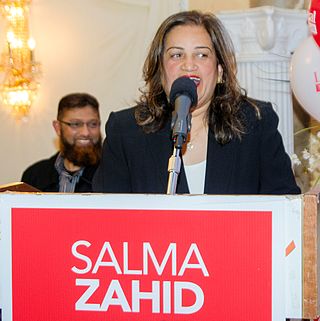Related Research Articles

The 1921 Canadian federal election was held on December 6, 1921, to elect members of the House of Commons of Canada of the 14th Parliament of Canada. The Union government that had governed Canada through the First World War was defeated, and replaced by a Liberal government under the young leader William Lyon Mackenzie King. A new third party, the Progressive Party, won the second most seats in the election.

Carolyn Ann Bennett is a Canadian physician and politician who has served as minister of mental health and addictions, and associate minister of health since October 26, 2021. A member of the Liberal Party, she has represented Toronto—St. Paul's in the House of Commons since 1997. She previously served as the minister of state for public health from 2003 to 2006, and the Minister of Crown–Indigenous Relations from 2015 to 2021. Bennett worked as a physician for 20 years before entering politics.
Gender representation has been a significant issue in Canadian politics.
Upon the dissolution of the 39th Canadian Parliament, 65 of the 308 seats were held by women. Canada ranks 45th in the world in representation of women in the national lower house.
The 40th Canadian Parliament contained a record number of female Members of Parliament, with 69 women elected to the House of Commons of Canada in the 2008 federal election. However, this represented just 22 per cent of the 308 total MPs, and only a modest gain over the 65 women in the 39th Canadian Parliament.
Bob Zimmer is a Canadian politician and a Member of Parliament in the House of Commons of Canada. He was elected to represent the riding of Prince George—Peace River in the 2011 election, and re-elected in the 2015 election, and the 2019 Canadian federal election, as a member of the Conservative Party of Canada. He served in both the 41st Parliament as part of the governing party, and 42nd Parliament as part of the official opposition.
The 41st Canadian Parliament includes a record number of female Members of Parliament, with 76 women elected to the House of Commons of Canada in the 2011 election. This represents a gain of seven seats over the previous record of 69 women in the 40th Canadian Parliament. By contrast, the 112th United States Congress had 72 women sitting in the 435-seat United States House of Representatives, and the 113th United States Congress has 81.

Salma Zahid is a Canadian politician, who was elected as a Member of Parliament in the House of Commons of Canada to represent the federal riding of Scarborough Centre during the 2015 Canadian federal election. She succeeded the Conservative Roxanne James.
The 42nd Canadian Parliament includes a record number of female Members of Parliament, with 88 women elected to the 338-member House of Commons of Canada (26%) in the 2015 election. This represents a gain of twelve seats over the previous record of 76 women in the 41st Canadian Parliament. By contrast, the 114th United States Congress had 105 women sitting in the 435-seat United States House of Representatives.
Women were first allowed to vote at the federal level in Canada in the 1917 general election in connection with military service, and were allowed to vote under the same conditions as men beginning on May 24, 1918. The next four elections saw only one woman elected: Agnes Macphail. The 1936 election saw two women in the House together for the first time. A by-election in 1941 saw a woman elected to the governing caucus for the first time. The 22nd federal election in 1953 was a slight breakthrough, electing four women, which was 1.5% of the House. Every Parliament thenafter would have at least two women at a time, except for the 28th Parliament from 1968 to 1972, in which Grace MacInnis was the only woman. Then 30th Parliament, elected in 1974, was another breakthrough, containing nine women MPs following the general election and rising to ten due to a by-election in 1976. The number of women in the House would not fall below ten again.

Emmanuella Lambropoulos is a Canadian politician serving as the Member of Parliament (MP) for Saint-Laurent since 2017. A member of the Liberal Party of Canada, she was elected to the House of Commons in a by-election, succeeding Stéphane Dion.
The 14th Canadian Parliament was the first Canadian parliament where a woman sat as a member. Women first became eligible to hold seats in the Canadian House of Commons on July 7, 1919. In the 1921 federal election, four women ran for seats in the House of Commons. Agnes Macphail was elected for a rural constituency in Ontario, becoming the first woman to hold a seat in the Canadian parliament.
During the 16th Canadian Parliament, women sat as members for the first time in both the House of Commons and the Senate. Two women ran for seats in the Canadian House of Commons in the 1926 federal election but Agnes Macphail, first elected in 1921, continued to be the only woman elected.
During the 18th Canadian Parliament, two women sat in the House of Commons for the first time. Sixteen women ran for seats in the Canadian House of Commons in the 1935 federal election. Agnes Macphail, first elected in 1921, was reelected in the newly created riding of Grey—Bruce. Martha Black, running in the place of her sick husband George Black as an independent Conservative, was elected for the Yukon riding, becoming the second woman to be elected to the House of Commons. Cairine Wilson and Iva Campbell Fallis continued to sit as members of the Senate.
During the 21st Canadian Parliament, the number of sitting women senators increased. Eleven women ran for seats in the Canadian House of Commons in the 1949 federal election; none were elected. However, Ellen Fairclough, who had run unsuccessfully in the Hamilton West riding as a Progressive Conservative, was elected in a May 1950 by-election held after the incumbent was appointed to the Ontario Supreme Court.
The number of women sitting in the House of Commons increased to six during the 26th Canadian Parliament; the number of women senators remained at six. 40 women ran for seats in the Canadian House of Commons in the 1963 federal election; two women out of five incumbents were reelected. Ellen Fairclough, Isabel Hardie and Margaret Mary Macdonald were defeated when they ran for reelection. Pauline Jewett and Margaret Konantz were elected to the House of Commons in the general election; Eloise Jones and Margaret Rideout were elected in by-elections held in June 1964.
The 43rd Canadian Parliament once again set a record number of female Members of Parliament, with 98 women elected to the 338-member House of Commons of Canada (28.9%) in the 2019 election. Of those 98 women, 31 were elected for the first time in the 2019 election. 2 more women were elected in by-elections in October 2020, reaching the historic milestone of 100 women in the House of Commons for the first time. This represents a gain of twelve seats over the previous record of 88 women in the 42nd Canadian Parliament. By contrast, the 116th United States Congress had 102 women sitting in the 435-seat United States House of Representatives (23.4%).

The 44th Canadian Parliament is the session of the Parliament of Canada which began on 22 November 2021, with the membership of the House of Commons, having been determined by the results of the 2021 federal election held on 20 September. Parliament officially resumed on 22 November with the re-election of Speaker Anthony Rota, and the Speech from the Throne read by Governor General Mary Simon the following day.
The 44th Canadian Parliament includes a record number of female Members of Parliament, with 103 women elected to the 338-member House of Commons of Canada (30.5%) in the 2021 election. Of those 103 women, 22 were elected for the first time in the 2021 election. This represents a gain of five seats over the previous record of 98 women elected at the beginning of the 43rd Canadian Parliament, and a gain of three seats from the record high of 100 women during the previous parliamentary session following by-elections.